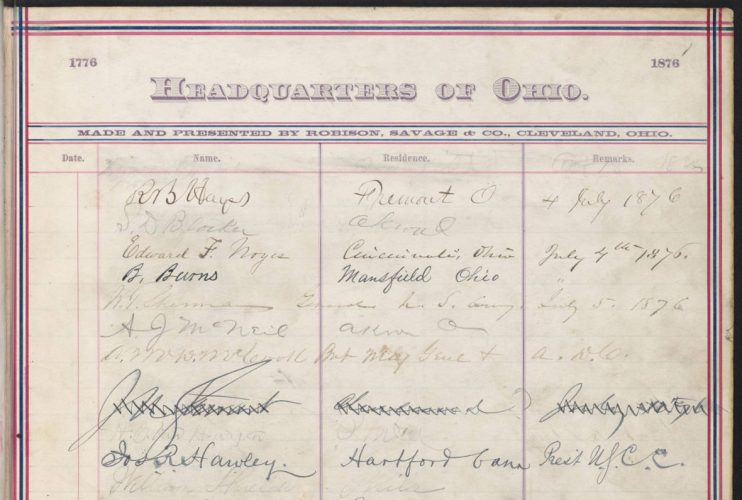“A Delightful Place”: The United States Centennial and the Ohio Building’s Registers

For six months in 1876, millions of people from all over the world traveled to Philadelphia, Pennsylvania, to celebrate the hundredth birthday of the United States. In Fairmount Park, representatives from America’s states, 37 nations and numerous industrial groups erected buildings in the park, totaling over 250 structures in all.
In the Ohio Building – a two-story structure built of sandstone quarried from each Ohio county and which is still standing today – blank registers were made available for visitors to sign their names, their place of origin, and leave notes. In all, four registers were filled during the six months of the Centennial Exposition and, after the event ended, those four registers were added to the permanent collection of the State Library of Ohio.
At the end of 2018, the registers were digitized and made available through Ohio Memory. Each contains between 15,000 and 20,000 signatures of visitors to the Ohio Building, with each visitor including his or her current hometown. Of the more than 60,000 signatures, the vast majority are from Ohioans, making the registers a remarkable piece of Ohio history.
Along with space for signatures and place of origin, the registers include room for remarks, and many exhibition attendees took advantage of that space. Some wrote comments on the building, such as “a delightful place,” or “a cozy retreat.” One attendee signed for himself and his companions, writing “very much pleased” in the comments section next to his name and “do…do,” an abbreviation for “ditto,” next to his friends’ names. Another attendee, apparently worn out from all of the excitement, wrote “I’m very tired.” Several others commented on politics, from federal elections (“three cheers for Hayes!” who was running for President at the time) to local, when someone noted that attendee Guido Marx, the mayor of Toledo from 1875-1877, was an “idiot.” And Charles Henderson, formerly of Columbus, left a note (at right) saying that he would be “glad to find” an old Cincinnati friend; this reader cannot quite decipher the name, but hopes that the two friends were able to reconnect!
By viewing the registers, we can see that exhibition attendees ranged from everyday Americans to the political elite. The aforementioned Rutherford B. Hayes signed in two registers, as Governor of Ohio and as a member of the U.S. Centennial Planning Commission. In fact, on the very first page of the first register (seen in part at the top of this post), one can find the signatures of Hayes as well as James Garfield and William T. Sherman, a remarkable collection of signatures from prominent Ohioans – two of whom went on to be elected President of the United States – all in one place.
Because people included their points of origin, and because they traveled as family and neighbor groups, we believe the registers provide a unique resource for genealogists, with descendants of attendees finding their ancestors in a specific location in time, often with their family members and neighbors. While the federal census, vital records, and the Social Security Death Index can provide sketches of many of our ancestors, it is the unexpected record – a letter, a photo, a journal – that colors the leaves of our family trees in vibrant shades of green. The Centennial Registers are yet another example of the types of records that give our trees color.
As of yet, the Registers are not indexed or searchable; transcription is required for such tools to be put into place, but the Registers have not yet been transcribed. We are researching options for transcription, however, so please be on the lookout for announcements in the future. Meanwhile, we hope that you will take some time to browse through the volumes, and that you’ll share any interesting tidbits that you come across! For more information on the Exhibition, please visit the Free Library of Philadelphia’s digital collection. Financially supported by the Institute of Museum and Library Services (IMLS), the collection contains a wealth of images and facts on the Exhibition, and was a major source of information for this blog post. To see the Ohio Building as it appeared to attendees of the exhibition, please click here (image also hosted by the Free Library of Philadelphia).
Thank you to Shannon Kupfer-Trausch, Digital Initiatives Librarian at the State Library of Ohio, for this week’s post!




Leave a Reply
You must be logged in to post a comment.